Dr Luke Yates - Faculty Fellowship
 Investigation of how RPA-coated ssDNA orchestrates genomic replication and stability
Investigation of how RPA-coated ssDNA orchestrates genomic replication and stability
Molecular machines involved in genome stability
The DNA that comprises the human genome is not static but is often modified by damaging agents from our environment. These damaging agents chemically modify or break the DNA and this can lead to mutations that, if left unrepaired, result in human disease and malignancy. Fortunately, humans and other organisms have evolved sophisticated mechanisms to recognise and repair damaged DNA – known as the DNA damage response. This response pathway is multi-step process inside the nucleus of the cell and involves many protein-based machines that signal the damage, recruit appropriate machines for the type of damage, and repair the DNA back to normal. My research is focusses on the signalling and recruitment steps within the process and I use techniques, such as electron microscopy, for example, to investigate the inner workings of these machines at the molecular/atomic scale.
Biography
I am a structural biologist using both X-ray crystallography and Electron Microscopy to understand protein structure and function, particularly in the context of human disease. After completing my D.Phil in Clinical Medicine (Structural Biology) at the University of Oxford in 2012, I continued as a Postdoctoral Research Associate and co-led a Cancer Research UK-funded drug discovery project based on my graduate research. I moved to Imperial College London to utilise cryogenic electron microscopy (cryo EM) to dissect protein complexes involved in the DNA damage response pathway. Over my research career, I have published 17 scientific papers in peer-reviewed journals, including Nature Communications, Nature Structure and Molecular Biology, and Cell. Outside of research I dedicate my time to medical ethics and charity work, driven by personal tragedy, and this has allowed me to develop a unique understanding of science and research’s role within society.


